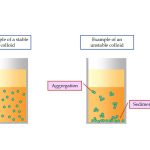The origin of the charge on the sol particles in most cases is due to the preferential adsorption of either positive or negative ions on their surface. The sol particles acquire electrical charge in any one or more of the following ways.
(1) Due to the dissociation of the surface molecules : Some colloidal particles develope electrical charge due to the dissociation / ionisation of the surface molecules. The charge on the colloidal particles is balanced by the oppositely charged ions in the sol. For example, an aqueous solution of soap (sodium palmitate) which dissociates into ions as,
The cations (Na+) pass into the solution while the anions have a tendency to form aggregates due to weak attractive forces present in the hydrocarbon chains.
(2) Due to frictional electrification
(i) It is believed that the frictional electrification due to the rubbing of the dispersed phase particles with that of dispersion medium results in some charge on the colloidal particles.
(ii) The dispersion medium must also get some charge, because of the friction. Since it does not carry any charge, the theory does not seem to be correct.
(3) Due to selective adsorption of ions
(i) The particles constituting the dispersed phase adsorb only those ions preferentially which are common with their own lattice ions.
(ii) For example, when a small quantity of silver nitrate solution is added to a large quantity of potassium iodide solution, the colloidal particles of silver iodide adsorb from the solution to become negatively charged, (at this stage is in excess, and being common to )

But, when a small quantity of potassium iodide solution is added to a large quantity of silver nitrate solution ; the colloidal silver iodide particles adsorb from the solution to become positively charged, (at this stage is in excess and is common to ),


(iii) Depending upon the nature of charge on the particles of the dispersed phase, the colloidal solutions are classified into positively charged and negatively charged colloids. Some typical examples are as follows



Comments are closed